It appears that the Japanese Space Agency (JAXA) has lost contact with a small probe released from its mothership Hayabusa on Saturday. After its release, the Minerva probe failed to make contact with the asteroid Itokawa’s surface, and controllers have no idea where it went. Hayabusa has been having problems with its positioning control system, so it’s possible that it put Minerva on an incorrect vector to reach the asteroid’s surface. Hayabusa is still scheduled to dip down and scoop some material off Hayabusa’s surface to return to Earth for analysis.
Spitzer’s Version of the Pillars of Creation
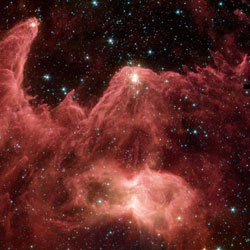
W5 star forming region in Cassiopeia. Image credit: NASA/JPL/Spitzer. Click to enlarge.
A new image from NASA’s Spitzer Space Telescope reveals billowing mountains of dust ablaze with the fires of stellar youth.
Captured by Spitzer’s infrared eyes, the majestic image resembles the iconic “Pillars of Creation” picture taken of the Eagle Nebula in visible light by NASA’s Hubble Space Telescope in 1995. Both views feature star-forming clouds of cool gas and dust that have been sculpted into pillars by radiation and winds from hot, massive stars.
The Spitzer image, which can be found at http://www.spitzer.caltech.edu/Media, shows the eastern edge of a region known as W5, in the Cassiopeia constellation 7,000 light-years away. This region is dominated by a single massive star, whose location outside the pictured area is “pointed out” by the finger-like pillars. The pillars themselves are colossal, together resembling a mountain range. They are more than 10 times the size of those in the Eagle Nebula.
The largest of the pillars observed by Spitzer entombs hundreds of never-before-seen embryonic stars, and the second largest contains dozens.
“We believe that the star clusters lighting up the tips of the pillars are essentially the offspring of the region’s single, massive star,” said Dr. Lori Allen, lead investigator of the new observations, from the Harvard-Smithsonian Center for Astrophysics, Cambridge, Mass. “It appears that radiation and winds from the massive star triggered new stars to form.”
Spitzer was able to see the stars forming inside the pillars thanks to its infrared vision. Visible-light images of this same region show dark towers outlined by halos of light. The stars inside are cloaked by walls of dust. But infrared light coming from these stars can escape through the dust, providing astronomers with a new view.
“With Spitzer, we can not only see the stars in the pillars, but we can estimate their age and study how they formed,” said Dr. Joseph Hora, a co-investigator, also from the Harvard-Smithsonian Center for Astrophysics.
The W5 region and the Eagle Nebula are referred to as high-mass star-forming regions. They start out as thick and turbulent clouds of gas and dust that later give birth to families of stars, some of which are more than 10 times more massive than the sun. Radiation and winds from the massive stars subsequently blast the cloudy material outward, so that only the densest pillar-shaped clumps of material remain. The process is akin to the formation of desert mesas, which are made up of dense rock that resisted water and wind erosion.
According to theories of triggered star formation, the pillars eventually become dense enough to spur the birth of a second generation of stars. Those stars, in turn, might also trigger successive generations. Astronomers do not know if the sun, which formed about five billion years ago, was originally a member of this type of extended stellar family.
Allen and her colleagues believe they have found evidence for triggered star formation in the new Spitzer image. Though it is possible the clusters of stars in the pillars are siblings of the single massive star, the astronomers say the stars are more likely its children.
Luis Chavarria is also a member of the investigating team at the Harvard-Smithsonian Center for Astrophysics. This research was originally led by Dr. Lynne Deutsch of the Center for Astrophysics, who passed away April 2, 2004.
For graphics and more information about Spitzer, visit , http://www.spitzer.caltech.edu/spitzer/ . To view or download Hubble’s Pillars of Creation image, visit http://hubblesite.org/newscenter/newsdesk/archive/releases/1995/44/image/a . For more information about NASA and agency programs on the Web, visit http://www.nasa.gov/home/ .
The image is also available in a NASA TV video file that airs beginning at 9 a.m. Eastern time. NASA TV’s Public, Education and Media channels are available on an MPEG-2 digital C-band signal accessed via satellite AMC-6, at 72 degrees west longitude, transponder 17C, 4040 MHz, vertical polarization. In Alaska and Hawaii, they’re on AMC-7 at 137 degrees west longitude, transponder 18C, at 4060 MHz, horizontal polarization. A Digital Video Broadcast compliant Integrated Receiver Decoder is required for reception. For digital downlink information for each NASA TV channel and access to NASA TV’s Public Channel on the Web, visit http://www.nasa.gov/ntv .
NASA’s Jet Propulsion Laboratory, Pasadena, Calif., manages the Spitzer mission for NASA’s Science Mission Directorate. Science operations are conducted at the Spitzer Science Center at the California Institute of Technology in Pasadena. JPL is a division of Caltech. NASA’s Goddard Space Flight Center, Greenbelt, Md., built Spitzer’s infrared array camera, which took the observations. The instrument’s principal investigator is Dr. Giovanni Fazio of the Harvard-Smithsonian Center for Astrophysics.
Original Source: NASA/JPL/Spizer News Release
Podcast: Larry Esposito and Venus Express
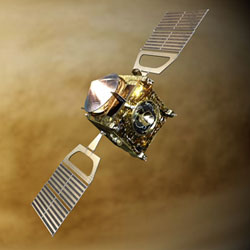
Artist illustration of Venus Express. Image credit: ESA. Click to enlarge.
Listen to the interview: Larry Esposito and Venus Express (5.5 MB)
Or subscribe to the Podcast: universetoday.com/audio.xml
Fraser: First, congratulations on today’s launch.
Larry Esposito: The launch went very well. Venus Express spacecraft is now on its way to Venus.
Fraser: And how is the spacecraft?
Esposito: Everything appears to be perfectly healthy. Everything is as expected at the moment.
Fraser: That’s good. It almost seems unusual. A lot of the time there are glitches, so it’s great to hear that everything’s going so well.
Esposito: The spacecraft did take a two-week delay while they looked for possible contamination, but it had not been contaminated so everything is looking very good at the moment.
Fraser: Okay, so let’s fast forward a few months into April when Venus Express does arrive at Venus. What’s going to happen?
Esposito: The spacecraft arrives at Venus on the 11th of April, 2006, and then goes into orbit around Venus by firing some retro-rockets. After that, there’s a period of commissioning the spacecraft, where the instruments and all the systems aboard are checked out. And then Venus Express begins observing the atmosphere, the clouds, and the surface of Venus.
Fraser: What scientific instruments does Venus Express bring to Venus that haven’t been there before?
Esposito: Venus Express is carrying telescopes and cameras that are similar to those that have previously been in orbit around Venus. But it benefits from better technology and also from a capability to look through the atmosphere at a very specific wavelength where the atmosphere is more transparent and it’s possible to actually see the surface of Venus.
Fraser: What kinds of mysteries are you hoping to reveal with this mission?
Esposito: Venus is considered by many to be a twin of Earth. It’s almost the same size, it was formed at the same time around the Sun, it receives about the same amount of light from the Sun as the Earth. And the question that we have, probably the most basic question, is giving that they’re nearly twin planets, what went wrong on Venus? Venus, if anything, is an evil twin of the Earth. Its surface temperature is as hot as the inside of a self-cleaning oven. It has pressure of 100 times that of the atmospheric pressure of the surface of the Earth. The atmosphere is filled with sulphurous gasses and completely shrouded by clouds. So Venus, in some way has gone terribly wrong compared to the Earth. The mystery may be how global warming on Venus got out of control and put it into the state it’s currently in. And on the Earth, where we’re experimenting with our own atmosphere by releasing greenhouse gasses, though the burning of oil and coal, the question is: could the Earth go along the same path? So one of the basic mysteries is, how did Venus go wrong, and how can we avoid that on the Earth? I’d like to say it’s much better to do a theoretical study and experiments on Venus instead of doing the experiments on Earth through global warming, where the result may be very poo for the future of life on the Earth. So the biggest mystery has to do with the history of Venus and the potential for the Earth to follow that path.
Fraser: What kind of evidence would you be looking for to tell you what might have sent Venus down that path?
Esposito: Measurements that Venus Express will be taking are measurements of the composition of Venus’ atmosphere, the motions of the atmosphere, and measurements of how sunlight absorbs into the atmosphere of Venus. In addition to that, the spacecraft will be looking through the atmosphere and measuring the temperature of the surface. So it could well be that the history of Venus’ climate is very much related to geological activity, volcanic activity, on the surface. So we’ll be looking for signs of active volcanoes, we’ll be looking for volcanic gasses in the atmosphere, we’ll be looking for absorbing compounds that could capture some of the Sun’s radiation, that warm Venus’ atmosphere. And in addition to that, that spacecraft has an objective to look for the possibility of any connection the environment has to the possibility of past or present life on Venus.
Fraser: And what kinds of additional challenges went in to build the spacecraft to let it be able to survive the environment there. Isn’t it very much related to the Mars Express spacecraft?
Esposito: Right, and luckily for the Europeans, who have built and launched and are operating the spacecraft, it doesn’t have to enter the Venus environment. It simply goes into orbit around Venus the way the Mars Express mission is in orbit around Mars. And it’s essentially a copy of that mission. So the spacecraft remotely senses through cameras and telescopes and spectrometers the Venus environment but it doesn’t actually enter into it. That would be a much more difficult, much more expensive, technical task and that’s not the mission of Venus Express.
Fraser: I know it’s been done briefly in the past by the Russians. Are there any plans in the near or far future to try and get back down onto the surface?
Esposito: The US National Research Council has issued a report about new frontiers in exploring the Solar System, and one of their top four missions is a mission that would land on the surface of Venus and investigate that surface. And in response to that recommendation by the National Research Council, I led a team that developed a proposal for a mission that would land on the surface of Venus and drill into sample the surface and atmosphere. But unfortunately NASA has declined to fly that mission at the present time. It’s possible that we’ll propose something like that in the future. But right now, the techincal and financial challenges were too large for NASA to take on at the moment.
Fraser: And one of the questions I always want to ask the people working on these missions is that a lot of the time there are pretty big surprises; some of them are expected, and some you have a hope that you’re going to find something. What would be one of the big surprises that you think might be waiting for us at Venus?
Esposito: Of course you’re right, there are always many surprises ahead, even after all the missions that have flown to Venus. And I’d particularly like to see some confirmation of volcanic activity. Another possible surprise is the identification of ultraviolet absorbers and the possibility that they might be connected with life forms in the Venus atmosphere. As the other surprises, it’s hard to predict. Maybe we’ll just be surprised because this Venus mission is more capable than any that have been sent into orbit Venus, and just maybe be able to find out things that we have no expectation. Anything that was related to volcanic eruptions and life would be very interesting on Venus.
Fraser: I’d read that recently that something is blocking ultraviolet light in the high atmosphere and that could actually create an ecosystem that life could survive in?
Esposito: We know definitely that there are ultraviolet absorbers in the clouds, but we haven’t been able to identify them, yet. The fact that they absorb sunlight could be the start of some biological ecosystem in the Venus clouds. That’s pretty speculative at the moment, but very interesting to think of those possibilities. And Venus express will be observing in ways that could shed more light on that question, on Venus life at the present time.
Fraser: I know Mars Express has equipment that can detect methane in the Martian atmosphere. Would there be something similar…
Esposito: The same experiment is flying on Venus express – the Planetary Fourier Spectrometer – on Venus Express, and it could also detect methane and other chemicals in Venus’ atmosphere. But methane is very unlikely at Venus because of the high temperatures and the strong sunlight there.
Fraser: So the sunlight would be destroying the methane quickly on Venus as it would be on Mars. If there was methane, it would be…
Esposito: Yes, sunlight and heat are very disruptive to methane.
Fraser: So the spacecraft is equipped to detect it, but it would be quite surprising if it was there.
Esposito: That’s right.
Lunar Lawn Mower
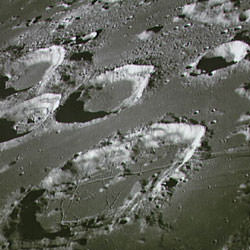
Lunar surface from Apollo 17. Image credit: NASA. Click to enlarge.
“If you can’t lick ’em, join ’em,” goes a cliché that essentially means “figure out how to live with whatever you can’t get rid of.”
That may be superb advice for living and working on the moon.
Scientists and engineers figuring out how to return astronauts to the moon, set up habitats, and mine lunar soil to produce anything from building materials to rocket fuels have been scratching their heads over what to do about moondust. It’s everywhere! The powdery grit gets into everything, jamming seals and abrading spacesuit fabric. It also readily picks up electrostatic charge, so it floats or levitates off the lunar surface and sticks to faceplates and camera lenses. It might even be toxic.
So what do you do with all this troublesome dust? Larry Taylor, Distinguished Professor of Planetary Sciences at the University of Tennessee has an idea:
Don’t try to get rid of it–melt it into something useful!
“I’m one of those weird people who like to stick things in ordinary kitchen microwave ovens to see what happens,” Taylor confessed to several hundred scientists at the Lunar Exploration Advisory Group (LEAG) conference at NASA’s Johnson Space Center last month.
At home in Tennessee, his most famous experiment involves a bar of Irish Spring soap, which quickly turns into “an abominable monster” when you hit the microwave’s Start button. But that’s not the one he told about at LEAG.
Apropos to the moon, he once put a small pile of lunar soil brought back by the Apollo astronauts into a microwave oven. And he found that it melted “lickety-split,” he said, within 30 seconds at only 250 watts.
The reason has to do with its composition. The lunar regolith, or soil, is produced when micrometeorites plow into lunar rocks and sand at tens of kilometers per second, melting it into glass. The glass contains nanometer-scale beads of pure iron – so called “nanophase” iron. It is those tiny iron beads that so efficiently concentrate microwave energy that they “sinter” or fuse the loose soils into large clumps.
This observation has inspired Taylor to imagine all kinds of machinery for sending to the moon that could fuse lunar dust into useful solids.
“Picture a buggy pulled behind a rover that is outfitted with a set of magnetrons,” that is, the same gizmo at the guts of a microwave oven. “With the right power and microwave frequency, an astronaut could drive along, sintering the soil as he goes, making continuous brick down half a meter deep–and then change the power settings to melt the top inch or two to make a glass road,” he suggested.
“Or say that you want a radio telescope,” he continued. “Find a round crater and run a little microwave ‘lawnmower’ up and down the crater’s sides to sinter a smooth surface. Hang an antenna from the middle–voila, instant Arecibo!” he exclaimed, referring to the giant 305-meter-diameter radio telescope in Puerto Rico formed out of a natural circular valley.
Technical challenges remain. Sintering moondust in a microwave oven on Earth isn’t the same as doing it on the airless moon. Researchers still need to work out details of a process to produce strong, uniformly sintered material in the harsh lunar environment.
But the idea has promise: Sintered rocket landing pads, roads, bricks for habitats, radiation shielding–useful products and dust abatement, all at once.
“The only limit,” says Taylor, “is imagination.”
Original Source: Science@NASA News Release
Three of Saturn’s Moons
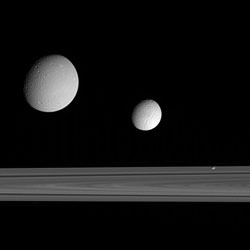
Dione, Tethys and Pandora. Image credit: NASA/JPL/SSI. Click to enlarge.
This excellent grouping of three moons –Dione, Tethys and Pandora– near the rings provides a sampling of the diversity of worlds that exists in Saturn’s realm.
A 330-kilometer-wide (205 mile) impact basin can be seen near the bottom right on Dione (at left). Ithaca Chasma and the region imaged during the Cassini spacecraft¿s Sept. 24, 2005, flyby can be seen on Tethys (middle). Little Pandora makes a good showing here as well, displaying a hint of surface detail.
Tethys is on the far side of the rings in this view; Dione and Pandora are much nearer to the Cassini spacecraft.
Dione is 1,126 kilometers (700 miles) across. Tethys is 1,071 kilometers (665 miles) across and Pandora is 84 kilometers (52 miles) across.
This image was taken in visible blue light with the Cassini spacecraft narrow-angle camera on Sept. 22, 2005, at a distance of approximately 1.2 million kilometers (800,000 miles) from Saturn. The image scale is about 5 kilometers (3 miles) per pixel on Dione and Pandora and 9 kilometers (6 miles) per pixel on Tethys.
The Cassini-Huygens mission is a cooperative project of NASA, the European Space Agency and the Italian Space Agency. The Jet Propulsion Laboratory, a division of the California Institute of Technology in Pasadena, manages the mission for NASA’s Science Mission Directorate, Washington, D.C. The Cassini orbiter and its two onboard cameras were designed, developed and assembled at JPL. The imaging operations center is based at the Space Science Institute in Boulder, Colo.
For more information about the Cassini-Huygens mission visit http://saturn.jpl.nasa.gov . The Cassini imaging team homepage is at http://ciclops.org .
Original Source: NASA/JPL/SSI News Release
Jupiter’s Winds Come From Inside
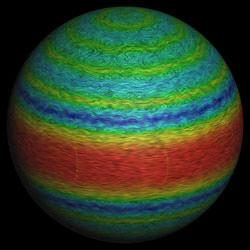
Computer simulation of Jupiter. Image credit: UCLA. Click to enlarge.
A new computer model indicates Jupiter’s massive winds are generated from deep within the giant planet’s interior, a UCLA scientist and international colleagues report today in the journal Nature.
Jupiter’s powerful winds are very different from those on Earth. They continually circle the planet, and have changed very little in the 300 years that scientists have studied them. Massive east-west winds in Jupiter’s equatorial region reach approximately 340 miles per hour ? twice as rapid as winds generated by strong hurricanes on Earth. At higher latitudes, the wind pattern switches to alternating jets that race around the planet.
No one has been able to explain why the winds are so constant or what generates them ? but that may change.
“Our model suggests convection driven by deep internal heat sources power Jupiter’s surface winds,” said Jonathan Aurnou, UCLA assistant professor of planetary physics. “The model provides a possible answer to why the winds are so stable for centuries. Jupiter’s surface is the tail; the dog is the hot interior of the planet.
“On Earth,” Aurnou said, “we get strong changes in wind patterns every season. On Jupiter, there is almost no variation. There are changing cloud structures, but the large-scale winds remain essentially constant.”
The researchers identified key ingredients that explain Jupiter’s “super winds” and factored those into their model. Aurnou’s colleagues are Moritz Heimpel, assistant professor of physics at the University of Alberta in Edmonton, and Johannes Wicht at the Max Planck Institute for Solar System Research in Germany.
Aurnou, Heimpel and Wicht created the first three-dimensional computer model that generates both a large eastward equatorial jet and smaller alternating jets at higher latitudes. In a rapidly rotating shell of fluid, they modeled thermally driven convection, which is what drives motion in a boiling pot.
“Three critical ingredients are the correct geometry, turbulent convection and rapid rotation, and our model contains all three elements,” said Aurnou, a faculty member in UCLA’s Department of Earth and Space Sciences. “When you include all those, that gives us the right recipe. In the future, we’ll refine our model by adding even more ingredients.”
Jupiter’s radius is more than 11 times the radius of Earth. A tremendous amount of heat comes from the interior.
“The heat from Jupiter’s interior is comparable to the heat the planet receives from the sun,” Aurnou said.
The model suggests three-dimensional convection in Jupiter’s deep atmosphere is likely driving the zonal flows, Aurnou said.
Jupiter’s interior is made primarily of compressed hydrogen and helium, and a giant plasma.
Aurnou will continue to study Jupiter’s strong winds, as well as those on Saturn, Uranus and Neptune.
Original Source: UCLA News Release
Young Star Gets Pushy
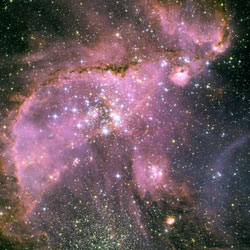
NGC 346 in the Small Magellenic Cloud. Image credit: Hubble. Click to enlarge.
This is a Hubble Space Telescope view of one of the most dynamic and intricately detailed star-forming regions in space, located 210,000 light-years away in the Small Magellanic Cloud (SMC), a satellite galaxy of our Milky Way. At the center of the region is a brilliant star cluster called NGC 346. A dramatic structure of arched, ragged filaments with a distinct ridge surrounds the cluster.
A torrent of radiation from the cluster’s hot stars eats into denser areas creating a fantasy sculpture of dust and gas. The dark, intricately beaded edge of the ridge, seen in silhouette by Hubble, is particularly dramatic. It contains several small dust globules that point back towards the central cluster, like windsocks caught in a gale.
Energetic outflows and radiation from hot young stars are eroding the dense outer portions of the star-forming region, formally known as N66, exposing new stellar nurseries. The diffuse fringes of the nebula prevent the energetic outflows from streaming directly away from the cluster, leaving instead a trail of filaments marking the swirling path of the outflows.
The NGC 346 cluster, at the center of this Hubble image, is resolved into at least three sub-clusters and collectively contains dozens of hot, blue, high-mass stars, more than half of the known high-mass stars in the entire SMC galaxy. A myriad of smaller, compact clusters is also visible throughout the region.
Some of these mini-clusters appear to be embedded in dust and nebulosity, and are sites of recent or ongoing star formation. Much of the starlight from these clusters is reddened by local dust concentrations that are the remnants of the original molecular cloud that collapsed to form N66.
An international team of astronomers, led by Dr. Antonella Nota of the Space Telescope Science Institute/European Space Agency in Baltimore, has been studying the Hubble data. In an upcoming issue of Astrophysical Journal Letters the team reports the discovery of a rich population of infant stars scattered around the young cluster NGC 346. These stars are likely to have formed 3 to 5 million years ago, together with the other stars in the NGC 346 cluster. These infant stars are particularly interesting as they have not yet contracted to the point where their interiors are hot enough to convert hydrogen to helium.
The Small and Large Magellanic Clouds are diffuse irregular galaxies visible to the naked eye in the southern hemisphere. They are two smallish satellite galaxies that orbit our own Milky Way Galaxy on a long slow journey inwards towards a future union with the Milky Way. Hubble has resolved many star formation regions in both of these neighboring galaxies that provide astronomers with laboratories other than our own Milky Way Galaxy to study how young stars interact with and shape their environments. The two satellites are named after the Portuguese seafarer Ferdinand Magellan (1480-1521) who sailed from Europe to Asia and is best known as the first person to lead an expedition to circumnavigate the globe.
This image of NGC 346 and its surrounding star formation region was taken with Hubble’s Advanced Camera for Surveys in July 2004. Two broadband filters that contribute starlight from visible and near-infrared wavelengths (shown in blue and green, respectively) have been combined with light from the nebulosity that has passed though a narrow-band hydrogen-alpha filter (shown in red).
Original Source: Hubble News Release
Podcast: Larry Esposito and Venus Express
Venus is our nearest planetary neighbour. Compared to the Earth, it’s nearly identical in size and distance from the Sun. But that’s where the similarities end. While we enjoy our comfortable temperature, pressure and atmosphere, Venus’ environment is downright hostile to life. The European Space Agency’s Venus Express blasted off for our “evil twin” planet today, and will hope to help answer the question: what went wrong? My guest today is Larry Esposito from the Laboratory for Atmospheric and Space Physics at the University of Colorado. He’s a member of the Venus Express science team.
Continue reading “Podcast: Larry Esposito and Venus Express”
Liftoff for Venus Express
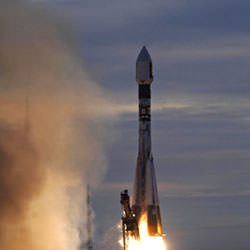
Venus Express atop a Soyuz rocket. Image credit: ESA. Click to enlarge.
The European spacecraft Venus Express has been successfully placed into a trajectory that will take it on its journey from Earth towards its destination of the planet Venus, which it will reach next April.
A virtual twin sister of the Mars Express spacecraft which has been orbiting the Red Planet since December 2003, Venus Express is the second planet-bound probe to be launched by the European Space Agency.
Venus Express will eventually manoeuvre itself into orbit around Venus in order to perform a detailed study of the structure, chemistry and dynamics of the planet’s atmosphere, which is characterised by extremely high temperatures, very high atmospheric pressure, a huge ‘greenhouse effect’ and as-yet inexplicable ‘super-rotation’ which means that it speeds around the planet in just four days.
The European spacecraft will also be the first orbiter to probe the planet’s surface while exploiting the ‘visibility windows’ recently discovered in the infrared waveband.
The 1240 kg mass spacecraft was developed for ESA by a European industrial team led by EADS Astrium with 25 main contractors spread across 14 countries. It lifted off on board a Soyuz- Fregat rocket, the launch service being provided by Starsem.
The lift-off from the Baikonur Cosmodrome in Kazahkstan this morning took place at 09:33 local time (04:33 Central European Time).
Initial Fregat upper-stage ignition took place nine minutes into the flight, manoeuvring the spacecraft into a low-earth parking orbit. A second firing, one hour and 22 minutes later, boosted the spacecraft to pursue its interplanetary trajectory.
Contact with Venus Express was established by ESA’s European Space Operations Centre (ESOC) at Darmstadt, Germany approximately two hours after lift-off. The spacecraft has correctly oriented itself in relation to the sun and has deployed its solar arrays.
All on-board systems are operating perfectly and the orbiter is communicating with the Earth via its low-gain antenna. In three days’ time, it will establish communications using its high-gain antenna.
Full speed ahead for Venus
Venus Express is currently distancing itself from Earth at full speed, heading on its five-month, 350 million kilometre journey inside our Solar System. After check-outs to ensure that its on-board equipment and instrument payload are in proper working order, the spacecraft will be ‘mothballed’, with contact with Earth being reduced to once daily. If needed, trajectory correction manoeuvres can go ahead at the half-way stage in January.
When making its closest approach, Venus Express will face far tougher conditions than those encountered by Mars Express on nearing the Red Planet. For while Venus’s size is indeed similar to that of Earth, its mass is 7.6 times that of Mars, with gravitational attraction to match.
To resist this greater gravitational pull, the spacecraft will have to ignite its main engine for 53 minutes in order to achieve 1.3 km/second deceleration and place itself into a highly elliptical orbit around the planet. Most of its 570 kg of propellant will be used for this manoeuvre.
A second engine firing will be necessary in order to reach final operational orbit: a polar elliptical orbit with 12-hour crossings. This will enable the probe to make approaches to within 250 km of the planet’s surface and withdraw to distances of up to 66 000 km, so as to carry out close-up observations and also get an overall perspective.
Exploring other planets to better understand planet Earth
“The launch of Venus Express is a further illustration of Europe’s determination to study the various bodies in our solar system,” stressed Professor David Southwood, the Director of ESA’s science programmes.
“We started in 2003 with the launch of Mars Express to the Red Planet and SMART-1 to the Moon and both these missions have amply exceeded our expectations. Venus Express marks a further step forward, with a view to eventually rounding off our initial overview of our immediate planetary neighbours with the BepiColombo mission to Mercury to be launched in 2013.”
“With Venus Express, we fully intend to demonstrate yet again that studying the planets is of vital importance for life here on Earth,” said Jean Jacques Dordain, ESA Director General.
“To understand climate change on Earth and all the contributing factors, we cannot make do with solely observing our own planet. We need to decipher the mechanics of the planetary atmosphere in general terms. With Mars Express, we are studying the Martian atmosphere. With Huygens, we have explored that of Saturn’s satellite Titan.
“And now with Venus Express, we are going to add a further specimen to our collection. Originally, Venus and the Earth must have been very similar planets. So we really do need to understand why and how they eventually diverged to the point that one became a cradle for life while the other developed into a hostile environment.”
The Venus Express mission is planned to last at least two Venusian days (486 Earth days) and may be extended, depending on the spacecraft’s operational state of health.
Twin sister of Mars Express
Venus Express largely re-uses the architecture developed for Mars Express. This has reduced manufacturing cycles and halved the mission cost, while still targeting the same scientific goals. Finally approved in late 2002, Venus Express was thereby developed fast, indeed in record time, to be ready for its 2005 launch window.
However, Venusian environmental conditions are very different to those encountered around Mars. Solar flux is four times higher and it has been necessary to adapt the spacecraft design to this hotter environment, notably by entirely redesigning the thermal insulation.
Whereas Mars Express sought to retain heat to enable its electronics to function properly, Venus Express will in contrast be aiming for maximum heat dissipation in order to stay cool.
The solar arrays on Venus Express have been completely redesigned. They are shorter and are interspersed with aluminium strips to help reject some solar flux to protect the spacecraft from temperatures topping 250ºC.
It has even been necessary to protect the rear of the solar arrays – which normally remain in shadow – in order to counter heat from solar radiation reflected by the planet’s atmosphere.
An atmosphere of mystery
Following on from the twenty or so American and Soviet missions to the planet carried out since 1962, Venus Express will endeavour to answer many of the questions raised by previous missions but so far left unanswered.
It will focus on the characteristics of the atmosphere, its circulation, structure and composition in relation to altitude, and its interactions with the planet’s surface and with the solar wind at altitude.
To perform these studies, it has seven instruments on board: three are flight-spare units of instruments already flown on Mars Express, two are from comet-chaser Rosetta and two were designed specifically for this mission.
The PFS high-resolution spectrometer will measure atmospheric temperature and composition at varying altitudes. It will also measure surface temperature and search for signs of current volcanic activity.
The SPICAV/SOIR infrared and ultraviolet spectrometer and the VeRa instrument will also probe the atmosphere, observing stellar occultation and detecting radio signals; the former will in particular seek to detect molecules of water, oxygen and sulphuric compounds thought to be present in the atmosphere.
The VIRTIS spectrometer will map the various layers of the atmosphere and conduct multi-wavelength cloud observation in order to provide images of atmospheric dynamics.
Assisted by a magnetometer, the ASPERA 4 instrument will analyse interaction between the upper atmosphere and the solar wind in the absence of magnetospheric protection such as that surrounding Earth (for Venus had no magnetic field). It will analyse the plasma generated by such interaction, while the magnetometer will study the magnetic field generated by the plasma.
The VMC camera will monitor the planet in four wavelengths, notably exploiting one of the ‘infrared windows’ revealed in 1990 by the Galileo spacecraft (when flying by Venus en route for Jupiter), making it possible to penetrate cloud cover through to the surface. The camera will also be used to monitor atmospheric dynamics, notably to observe the double atmospheric vortex at the poles, the origin of which still remains a mystery.
Original Source: ESO News Release
Lichen Can Survive in Space
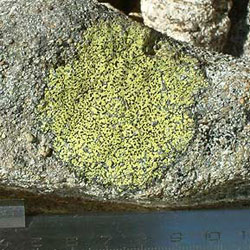
Rhizocarpon geographicum, species of lichen. Image credit: ESA. Click to enlarge.
One of the main focuses in the search for living organisms on other planets and the possibilities for transfer of life between planets currently centres on bacteria, due to the organisms simplicity and the possibility of it surviving an interplanetary journey exposed to the harsh space environment.
This focus may develop to encompass more advanced organisms following the results of an ESA experiment on the recent Foton-M2 mission where it was discovered that lichens are very adept at surviving in open space.
Lichens are not actually single organisms but an association of millions of algal cells, which cooperate in the process of photosynthesis and are held in a fungal mesh. The algal cells and the fungus have a symbiotic relationship, with the algal cells providing the fungus with food and the fungus providing the alga with a suitable living environment for growth. Lichens are well known extremophiles, being able to survive the harshest environments on Earth. The most striking element of the finding is the complexity of this organism: it is multicellular, it is macroscopic and it is a eukaryote, meaning that on the evolutionary scale it is a much more modern organism than bacteria. In fact lichens can be considered as very simple ecosystems.
The experiment which took place during the Foton mission was called ‘Lichens’ and was one of the exobiology experiments that was located in the ESA Biopan facility. This exposure facility was located on the outer shell of the Foton return module and, once at the correct orbital altitude, opened to exposure the samples inside to open space, i.e. exposed to vacuum, wide fluctuations of temperature, the complete spectrum of solar UV light and bombarded with cosmic radiation. During the Foton-M2 mission, which was launched into low-Earth orbit on 31 May 2005, the lichens, which came from two different species (Rhizocarpon geographicum and Xanthoria elegans) were exposed for a total 14.6 days before being returned to Earth. At the conclusion of the mission the lid of Biopan was closed to protect the lichens from the conditions of reentry. The Biopan was thereafter transported back to ESA ‘s research facility, ESTEC, in Noordwijk, the Netherlands to be opened.
The results of the experiment were presented by one of the experiment team members, Dr. Rosa de la Torre from the Spanish Aerospace Research Establishment (INTA) in Madrid, at a post-flight review in October at ESTEC. Initial conclusions of the experiment, which is under the scientific leadership of Prof. Leopoldo Sancho from the Complutense University of Madrid, indicate that lichens have the capacity to resist full exposure to the harsh space conditions, especially high levels of UV radiation. Analysis post flight showed a full rate of survival and an unchanged ability for photosynthesis.
This experiment opens up many possibilities for future research into the possibility of transfer of life between planets. Follow up experiments could focus on questions such as to what extent lichen, if transported by a meteorite, can survive the reentry conditions into Earth’s atmosphere, i.e. what degree of shielding would be needed for lichen samples to survive? The outcome of this Biopan experiment also suggests that lichens might survive at the surface of Mars. Follow-up experiments on ground and in space are bound to provide further answers to these intriguing astrobiological questions.
Original Source: ESO News Release
